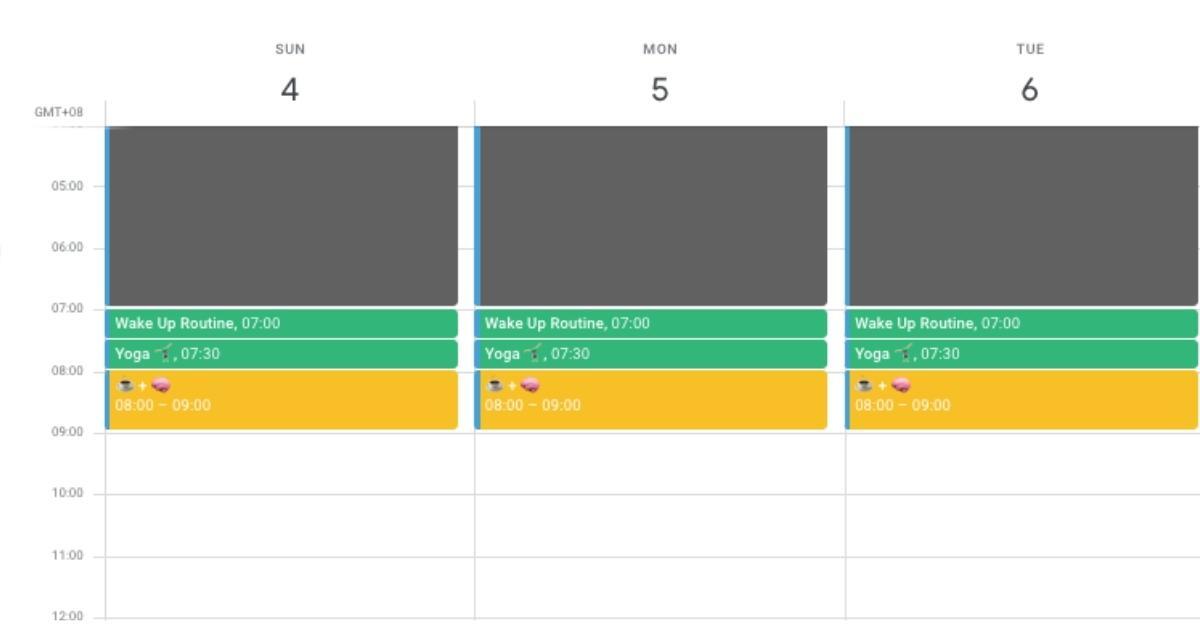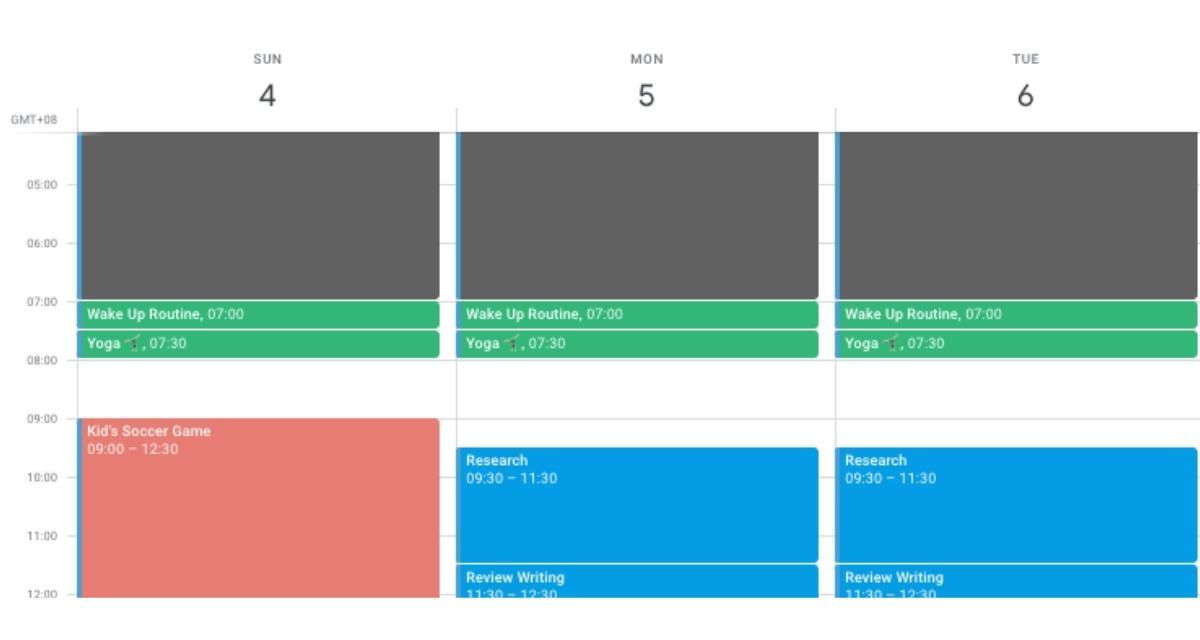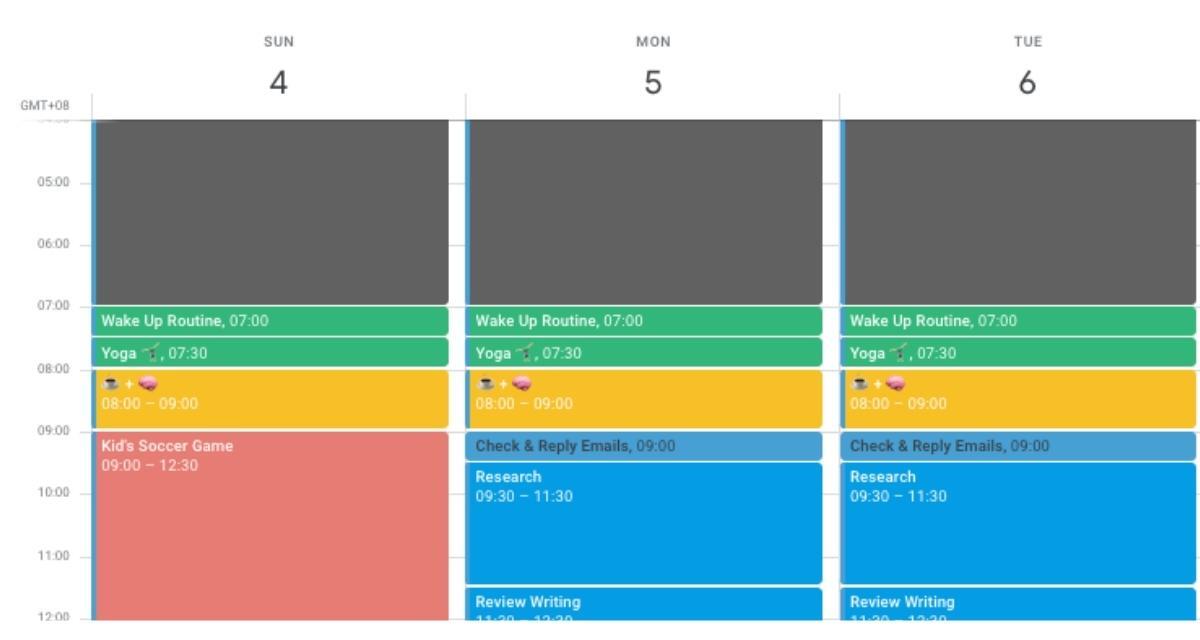This article by Tatiana Azman originally appeared on Mindvalley
Get milk, check. Pay bills, check. Call mom, check… Goodness gracious, it seems like that to-do list is a never-ending one. And when you’ve check, check, checked, it seems like there are even more things to add on.
This is where time blocking can help. And here’s a mini guide to get you started:
- What Is Time Blocking?
- Does Time Blocking Really Work?
- How to Use Time Blocking
Leave to-do lists for your grocery run. Instead, explore how this method is far more effective in managing your tasks and time.

What Is Time Blocking?
A standard to-do list tells you what needs to be done, but time blocking tells you when you’re going to do it. It’s based on implementation intentions, which is simply taking your intentions and implementing them into action.
It’s a great tool to use for those who:
- Juggle multiple projects or have many different responsibilities
- Have meetings throughout the day
- Get sidetracked often with emails, text messages, and social media
With this well-researched technique, you divide the day into blocks of time — hence the name “time blocking.” Each block is dedicated to accomplishing a specific task and only that task. For example, if you block off 8 a.m. to 9 a.m. to write your book, then writing’s the only thing you do in that block.
So why is time blocking important?
While to-do lists help you see your tasks visually and allow them to seem more manageable, time blocking helps you be more task-focused in your daily routine. It’s a tool that ensures you do the things that matter and ignore the things that don’t.
Time management variations
There are other techniques that are close cousins to time blocking: task batching, day theming, and timeboxing. Here’s the gist of each time management method:
| Method | What Is It? | Example |
| Time blocking | You divide your day into blocks of time. | “I will work on the first chapter every day from 9 a.m. to 10 a.m.“ |
| Task batching | You group smaller tasks that contribute to larger goals, working on them for a specific amount of time or until you complete a certain number of tasks. | “I will work on the first chapter at 9 a.m.“ |
| Day theming | Essentially just a more advanced version of task batching. | “Every Monday, I will do research for my book; every Tuesday, I will write an outline for a chapter; every Wednesday, I will write a chapter; etc.“ |
| Timeboxing | You allocate a fixed time period to a planned activity. | “I will finish writing the first chapter between 9 a.m. and 10 a.m. tomorrow.“ |
Time blocking vs. timeboxing
Time blocking is often used synonymously as timeboxing, the method that habit-forming expert Nir Eyal highly endorses in his best-selling book, Indistractable: How to Control Your Attention and Choose Your Life (which inspired Mindvalley to create the Becoming Focused and Indistractable Quest).
However, it’s important to note the difference:
- Time blocking. It’s essentially taking your to-do list and setting a specific task’s start and end times. It helps with planning your day to handle all the important tasks on your agenda.
For example, if you’re writing a book, your time block will be “working on a first draft of the first chapter from 9 a.m. to 10 a.m. tomorrow.” - Timeboxing. You set a limit on how much time you dedicate to a specific task, which is typically attached to a goal. It helps keep you running on schedule and become indistractable.
With the book example, your timeboxing will be “finishing a first draft of the first chapter tomorrow between 9 a.m. and 10 a.m.”
While timeboxing is a technique used by successful people like Elon Musk, Bill Gates, Nir Eyal, and even the founder of Mindvalley, Vishen, time blocking is still a wonderful way to get the most from your daily schedule.

Does Time Blocking Really Work?
Using a time-blocking planner gets you to step away from multi-tasking and helps you focus on one task at a time. It helps you plan your day in advance according to your values and schedule.
Here are a few studies that show why time blocking works:
- A 2018 research looked into imposing time pressure to reduce distractions. It found that “those under high time pressure exhibited a lower task distraction rate.”
- In a study published in the British Journal of Health Psychology, participants were asked to perform 20 minutes of exercise. It found that only 34% of them exercised that day when they didn’t plan it. However, when the intention was set into a plan, the follow-through rate increased to 91%.
- A review paper in Behavioral Science & Policy points out that people are more likely to carry out their tasks when they’re scheduled. The researchers wrote, “prompting people to make concrete and specific plans makes people more likely to act on their good intentions.”
Without the organization of time blocking, there’s a high potential we’ll fall into what’s known as Parkinson’s law: “Work expands so as to fill the time available for its completion.” It simply means that the more time you have to complete a task, the more time it’ll take you to actually do it.
How to Use Time Blocking
If you’re familiar with to-do lists, time blocking should be a breeze. Taking inspiration from Nir’s expertise on being “indistractable,” here’s a simple step-by-step to set up your own time-blocking planner.
1. Identify your values
In his book, Nir explains that the opposite of distraction is traction. He writes, “Traction draws you towards what you want in life, while distraction pulls you away.”
Oftentimes, we get distracted from being in the flow because we don’t make time for the things we value, especially our relationships and our self. However, when we identify our values, it creates traction.
There are three domains where we spend our time: You, Relationships, and Work. And as Nir suggests, identify your values in these categories. For example, in the “you” domain, it could be really important for you to have a self-love routine.
“In order to live our values in each of these domains, we must reserve time in our schedules to do so,” he points out. “Without planning ahead, it’s impossible to even tell the difference between traction and distraction.”
2. Write down a list of things to do
Once you’ve identified your values, write down a to-do list that encompasses these principles. It would be a list of things you’d want to do because they’re important to you.
Let’s go back to the “you” example. If a self-love routine helps your well-being, then a to-do task would maybe include getting a massage once a week.
More importantly, writing down your to-do’s gives you a clear outline of the bigger picture. And that’ll help motivate you to keep you moving forward.
3. Create a start block and an end block
It’s time to create your blocks. But before you start plugging in tasks, it’s a good idea to start with guardrails so that you know how you’ll start your morning and how you’ll end your day.
What’s your morning routine? And how do you want to wrap up your day before going to bed?
An example of the “you” domain, you could block off your morning with yoga to boost productivity for the rest of the day. And for the “relationship” domain, for instance, you could end the day with a movie with your family before calling it a night.
This will also ensure that you put your personal life at the forefront.

4. Add blocks for deep and shallow tasks
Now, you can start blocking off time in your day for all those other tasks on your to-do list.
For most, work takes up a chunk of the weekdays. If this applies to you, too, then try to chop it off into sessions instead of plugging in a block called “At Work.”
You can split it up into a balance of deep tasks (like writing, designing, coding, etc.) and shallow tasks (planning your day, taking a lunch break, etc.). Whatever works best for you.
For the days you’re not at work, deep tasks could include cleaning the house or taking the kids to the movies. And shallow tasks could include taking the dog for a walk or making dinner.

5. Add blocks for reactive tasks
Don’t forget about the emails to answer, calls to take, meetings to attend, social media to check, and so on and so forth. These are all considered reactive tasks — regular or routine tasks that need to be done.
These are the kinds of duties that can often lead to distraction if you’re attending to them throughout the day. However, with time blocking, you can choose when you do these tasks, which can help you take back the power you have over your time.

Bonus: Reflect and refine
Sometimes, something happens that can throw your whole schedule out of whack. It’s just life, and it happens.
Nir advises revising your schedule regularly. He mentions in his book that “the goal is to figure out where your schedule didn’t work out in the prior week so you can make it easier to follow the next time around.”
When you commit to this practice, it improves your time blocking over time. This will help you better understand the difference between traction and distraction, enabling you to identify them for every moment of the day.
Great Changes Start With You
Time blocking is one of the many great methods for time management. And it can absolutely help you be more in control of your time, focus, and productivity.
- Mindvalley

Don’t miss out on a single article!
Enjoy unlimited access to over 500 articles & podcast that give you a positive perspective on the state of the world and show you practical ways you can help.








